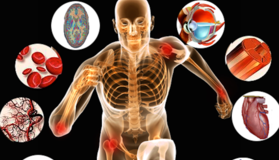Chapter 2
Fuel for Exercise: Bioenergetics and Muscle Metabolism
Energy Substrates
Energy for cell metabolism is derived from three substrates in foods: carbohydrate,fat, and protein. Proteins provide little of the energy used for metabolism under normal conditions.With in cells, the usable storage form of the energy we derive from food is thehigh-energy compound adenosine triphosphate or ATP. Carbohydrateand protein each provide about 4.1 kcal energy per gram, compared with about9.4 kcal/g for fat.
Carbohydrate,stored as glycogen in muscle and the liver, is more quickly accessible as an energysource than either protein or fat. Glucose, directly from food or brokendownfrom stored glycogen, is the usable form of carbohydrate.
Fat,stored as triglycerides in adipose tissue, is an ideal storage form of energy.Free fatty acids from the breakdown of triglycerides are converted to energy.
Carbohydratestores in the liver and skeletal muscle are limited to about 2,500 to 2,600kcal of energy, or the equivalent of the energy needed for about 40 km (25mi)of running. Fat stores can provide more than 70,000 kcal of energy.
Enzymes control the rate of metabolism and energy production. Enzymes can speed up the over all reaction by lowering the initial activation energy and by catalyzingvarious steps along the pathway.
Enzymes can be inhibited through negative feedback of subsequent pathway by products(or often ATP), slowing the overall rate of the reaction. This usually involvesa particular enzyme located early in the pathway called the rate-limitingenzyme.
The Basic Energy Systems
Cells can store only very limited amountsof ATP and must constantly generate new ATP to provide needed energy for allcellular metabolism, including muscle contraction.Cells generate ATP throughany one of (or a combination of) three metabolic path ways:
1. The ATP-PCr system
2. The glycolytic system (glycolysis)
3. The oxidative system (oxidativephosphorylation)
The first two systems can act inthe absence of oxygen and are jointly termed anaerobic metabolism. The third system requires oxygen and therefore comprises aerobic metabolism.
Interaction of the Energy Systems The three energy systems do not work independently of one another, and no activity is 100% supported by any singleenergy system. When a person exercises at the highest intensity possible, from the shortest sprints (less than 10 s) to endurance events (greater than 30min), each of the energy systems is contributing to the total energy needs ofthe body. Generally one energy system dominates energy production, except whenthere is a transition from the predominance of one energy system to another. Asan example, ina 10s, 100 m sprint, the ATP-PCr system is the predominant energysystem, but both the anaerobic glycolytic and the oxidative systems provide asmall portion of the energy needed.At the other extreme, in a 30 min, 10,000 m(10,936 yd) run, the oxidative system is predominant, but both the ATP-PCr andanaerobic glycolytic systems contribute some energy as well.
The Oxidative Capacity of Muscle
We have seen that the processes ofoxidative metabolism have the highest energy yields. It would be ideal if theseprocesses always functioned at peak capacity. But, as with all physiologicalsystems, they operate within certain constraints. The oxidative capacity ofmuscle (QO2) is a measure of its maximal capacity to use oxygen. Thismeasurement is made in the laboratory, where a small amount of muscle tissuecan be tested to determineits capacity to consume oxygen when chemicallystimulated to generate ATP. A muscle's oxidative capacity ultimately depends onits oxidative enzyme concentrations, fiber type composition, and oxygenavailability.
In Closing
In this chapter, we focused onenergy metabolism and the synthesis of the storage form of energy in the body,ATP. We described in some detail the three basic energy systems used togenerate ATP and their regulation and interaction. Finally, we highlighted theimportant role that oxygen plays in the sustained generation of ATP forcontinued muscle contraction and the three fiber types found in human skeletalmuscle. We next look at the neural control of exercising muscle.
Study Questions
1. What is ATP, how is it formed, and how does it provide energy during metabolism?
2.What is the primary substrate used to provide energy at rest? During high-intensity exercise?
3. What is the role of PCr in energy production, and what are its limitations? Describethe relationship between muscle ATP and PCr during sprint exercise.
4.Describe the essential characteristics of the three energy systems.
5. Why are the ATP-PCr and glycolytic energy systems considered anaerobic?
6. Whatrole does oxygen play in the process of aerobic metabolism?
7.Describethe by-products of energy production from ATP -PCr, glycolysis, and oxidation.


